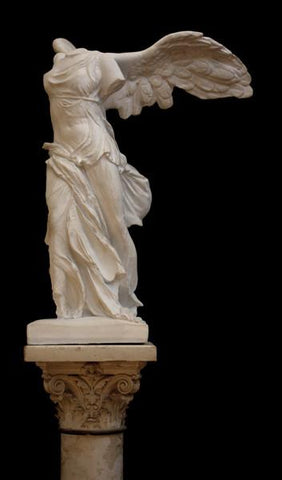Empty pedestals stood alone while windswept marble drapery and painted smiles were laboriously and carefully transported. This was Paris in the late 1930s, when much of the artwork from the Louvre was moved and stored offsite to steer clear of the dangers of World War II.
These frozen moments in art couldn’t avoid the changing situations around them. Among the pieces that were removed were the Winged Victory of Samothrace and the Venus De Milo, as well as, of course, the Mona Lisa.
One of our favorite articles on this subject, How France Hid the Louvre’s Masterpieces During WWII, describes it this way:
“The event was also an opportunity to view, often with unprecedented closeness, the museum’s most iconic works, suddenly brought down from their pedestals.”
The article describes much of the process and shows some breathtaking photos of the large sculptures scaffolded and secured for their journeys. Be sure to give it a read. A few other write-ups on the topic can be found here and here. There’s also a book by Gerri Chanel called Saving Mona Lisa: The Battle to Protect the Louvre and its Treasures from the Nazis.
If you want an opportunity to see finely-crafted reproductions of the Victory or Venus with “unprecedented closeness,” visit our gallery or check out the links below! (Sorry, but the Caproni brothers did not make a mold of the Mona Lisa!)
Victory of Samothrace - 39" - Item #76
A reduction of the famous sculpture. Found on the island of Samothrace in 1863, this statue is a personification of Victory, or Nike in Greek. It is believed the statue was meant to commemorate a Rhodian naval victory, such as that of Myonnisos or the one over Antiochus III of Syria early in the second century B.C.E.
We also offer the full-size sculpture and reductions at 29" and 19" in addition to the 39" version pictured above.
Venus de Melo (Reduction) - Item #78
Also known as the Aphrodite of Melos, this late 2nd century B.C.E. sculpture might be a replica due to its similarities with the Aphrodite of Capua in the National Archaeological Museum in Naples which dates from the late 4th century B.C.E. The sculpture was found on the island of Melos (Milo in modern Greek) in 1820, soon after which it was donated to the Louvre by King Louis XVIII.
We offer the full-size sculpture as well as reductions at 34" (pictured above) and 12". Then there is the full-size head and a small bust.
We hope you enjoyed learning a little more history around the original pieces!
Robert, Kathleen, Kayla and Lisa
Want content like this delivered to your inbox? Sign up for our newsletter!



